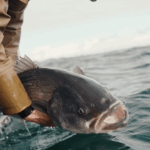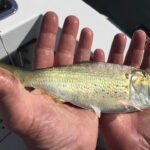
Release Mortality Revisited: New Research from Massachusetts DMF
Feature Photo Credit: Robbie Tartaglia What’s going on? For decades, striped bass management relied on a
Will Poston, Policy Consultant
Bluefish will tear your $9 rigged soft plastic to shreds. Same goes for that hunk of feathers that you spent 10 minutes tying. But these yellow-eyed devils are an iconic recreational species along the Atlantic coast. How many times has your day been saved by a marauding school of bluefish attacking topwater lures? The answer is probably “A LOT,” for good reason too—bluefish are just flat-out fun to catch. Unfortunately, over the past decade, the bluefish spawning stock biomass has declined, and the stock was declared overfished in 2019.[1]
Bluefish are jointly managed by the Atlantic States Marine Fisheries Commission (Commission) and the Mid-Atlantic Fishery Management Council (Council). The Commission and Council are currently working through an amendment process and are taking public comment through April 23, 2021—that’s this Friday! The amendment was initiated back in December 2017 to address several issues that became apparent in the fishery—notably, allocations to the commercial and recreational sectors and the practice of quota transfers between sectors (more on this later). Then, after the initial scoping process, the recalibrated Marine Recreational Information Program (MRIP) data resulted in an overfished designation and a realization that previous management decisions were extremely misguided.

The bluefish fishery is predominantly a recreational one. According to NOAA Fisheries, in recent years, the recreational sector has accounted for nearly 90% of the fishery’s total catch.[1] And within the recreational sector, the majority of fish caught are released—from 2010-2019, even with the federal bag limit at 15 fish per person and no size limit, Atlantic coast recreational anglers released about two thirds of the bluefish they caught annually.[2] This tells us that the opportunity for anglers to encounter, catch, and release bluefish is a bigtime driver of recreational fishing effort. It thus stands to reason that abundance should be a priority when considering bluefish management alternatives.
Managers are seeking public comment on the draft amendment, which looks at a variety of issues including commercial and recreational allocations, a rebuilding plan, and quota transfers. For more information, check out the Council’s website. Unlike striped bass, which are managed solely by the Commission, bluefish are subject to the strict federal management requirements of the Magnuson-Stevens Fishery Conservation and Management Act (MSA), which includes legal mandates to limit catch and promptly rebuild overfished stocks. These guardrails give us cautious optimism for bluefish’s recovery in the not-too-distant future. That being said, it’s important that managers hear your preferences regarding the bluefish fishery.
Follow along for our quick comment guide on the Bluefish Allocation and Rebuilding Amendment. For more detailed comments, see our full letter to the Council.
1. Fishery Management Plan (FMP) Goals and Objectives: The amendment’s proposed goals and objectives represent a beneficial, and much-needed, update for the FMP. While we support the proposed goals and objectives, we would like to see “optimum yield” discussed as an objective. MSA requires fisheries management measures to achieve optimum yield, which is defined as a fishery’s maximum sustainable yield “as reduced by any relevant economic, social, or ecological factor.”[3] In an ideal management regime, managers would manage the fishery for its optimum yield in order to achieve the greatest benefit. In the bluefish fishery, an optimum yield analysis could well show that the greatest value occurs in the recreational catch and release fishery, and that harvest levels less than maximum sustainable yield are preferred. However, such analysis is not being considered and management decisions are not necessarily reflecting the fishery’s true value.
2. Commercial and Recreational Allocation: Allocation decisions are never easy—there are usually clear winners and losers, as we at ASGA tend to focus on overall stock health rather than on who gets what piece of the pie. However, revisiting allocations from time to time is a necessary activity in order to achieve an efficiently performing fishery. The current allocations—83% recreational and 17% commercial[4]—were set 20 years ago and are based on data from the 1980s. Because the bluefish stock has generally been declining for a decade and is now overfished, it is important that managers base their allocation decision, at least in part, on years when the stock was healthy and abundant. Therefore, we support Alternative 2a-4 because it uses a combination approach of historic and recent data, all of which lead to the same result.
3. Commercial Allocations to the States: We are not taking a position on this issue.
4. Rebuilding Plan: This fishery needs to be rebuilt in a quick and efficient manner that is precautionary to the resource in its approach. We prefer Alternative 4c, a five-year rebuilding plan based on the Council’s risk policy that provides a flexible approach for rebuilding the stock while taking the appropriate steps to ensure recovery.
5. Quota Transfer Provisions: In fisheries management, “quota transfer” refers to the practicing of shifting unused quota—fish that aren’t harvested—from one fishing sector to another. In the bluefish fishery, transfers are currently only permitted from the recreational sector to the commercial. In practice, transfers can increase efficiency in a fishery by maximizing the amount of fish harvested within sustainable limits. However, with bluefish being a predominantly catch and release fishery on the recreational side, the recreational sector is “punished” for releasing fish in the form of losing quota. An enormous component of the recreational fishery’s value comes from catch and release; the practice of transfers ignores and diminishes that value and leads to fewer fish in the water. Additionally, from what we now know with the revised MRIP estimates, none of the past recreational-to-commercial transfers should have even happened in the first place because the recreational sector was catching more fish than previously understood. We are against transfers in this fishery, as it disincentivizes releasing fish and perpetuates a fundamental misunderstanding of the fishery. For these reasons, we support removing quota transfers from the Bluefish FMP.
6. Management Uncertainty Alternatives: Management uncertainty is an intrinsic part of fisheries management, and in the bluefish fishery managers consider this uncertainty at a fishery-wide level, reducing allowable catch by a buffer. Accounting for management uncertainty in each sector separately (commercial and recreational), rather than for the overall fishery, makes perfect sense, and if you’ve been following ASGA, you know that recreational accountability is a top priority of ours. While we would like to learn more about the specifics of how recreational uncertainty will be considered in reducing recreational harvest limits, we support Alternative 6b, the post-sector split.
7. De Minimis Provisions: De minimis status is afforded to states who contribute minimally to the coastwide bluefish fishery. De minimis states are exempted from independent monitoring requirements. We support Alternative 7a, the status quo.
Coastal recreational anglers are in a challenging stretch, with their most important species, striped bass, at a 25-year low. While bluefish won’t replace stripers, nor should they, they offer a great alternative for coastal anglers and the businesses that depend on our marine resources. Efficiently rebuilding bluefish will benefit guides, charter captains, tackle shops, private anglers, shore-bound anglers, and the new angler who has never experienced the drag-pulling ability of a gator blue.

Feature Photo Credit: Robbie Tartaglia What’s going on? For decades, striped bass management relied on a

Recent developments in the 2025 Atlantic Menhaden Stock Assessment Update, released by the Atlantic States

What’s going on? The “most important fish in the sea” just exposed one of the

Mario CampoFisheries Ecologist, Southeastern Louisiana UniversityScience and Policy Associate, American Saltwater Guides Association This discussion
We rely on our members and donations to keep fighting for a sustainable tomorrow in marine conservation.
GIVE THE GIFT OF FISHERIES CONSERVATION THIS HOLIDAY SEASON. SHOP ASGA GOODS THAT FUND FISHERIES RESEARCH & ADVOCACY CAMPAIGNS
JOIN ASGA IN CALLING FOR CRITICAL MANAGEMENT ACTION AFTER YEARS OF SPAWN FAILURES & POOR MANAGEMENT.
By using this website, you agree to our use of cookies. We use cookies to provide you with a great experience and to help our website run effectively. To learn more, please review our privacy policy.
4 Responses
I believe beach replenishment is pushing bluefish further offshore. Zero research has been done on the impact that beach replenishment has caused to fish habitat. The army corps of engineers year after year covers jetties with sand and covers the beaches with lifeless dead sand.
Any limits are fine too many fisherman take excess fish that are wasted
Tony and Willy,
Thank you for your guidance to help the rest of try to make an impact. This matters.
Capt. Parker Mauck
Westport Fly